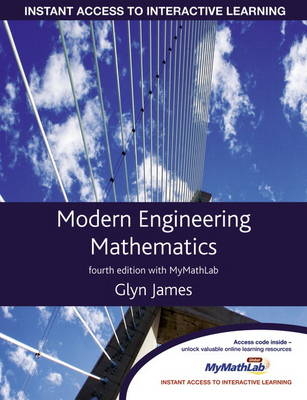
Online Course Pack:Modern Engineering Mathematics with MyMathLab/Modern Engineering Mathematics MML royalty/ MyMathLab Global Student Access Card:MML Global STU card_p1 Plus MATLAB & Simulink Student Version 2010a
Prentice-Hall
978-1-4082-6410-2 (ISBN)
- Titel ist leider vergriffen;
keine Neuauflage - Artikel merken
This book provides a complete course for first-year engineering mathematics. Whichever field of engineering you are studying, you will be most likely to require knowledge of the mathematics presented in this textbook. Taking a thorough approach, the authors put the concepts into an engineering context, so you can understand the relevance of mathematical techniques presented and gain a fuller appreciation of how to draw upon them throughout your studies.
This MyMathLab edition comes with student access to MyMathLab Global (R), a powerful online homework, tutorial and self study system to enrich your learning. Containing hundreds of extra practice questions to support your study of each topic in the book - MyMathLab Global provides automatic, instant feedback and support tools to help you better understand the mathematical concepts.
Professor Glyn James is Emeritus Professor within the Department of Mathematical Sciences at Coventry University, having previously been Dean of the School of Mathematical and Information Science. As in previous editions he has drawn upon the knowledge and experience of his co-authors to provide an excellent revision of the book.
Chapter 1: Numbers, Algebra and Geometry
1.1 Introduction
1.2 Number and arithmetic
1.3 Algebra
1.4 Geometry
1.5 Numbers and accuracy
1.6 Engineering applications
1.7 Review exercises
Chapter 2: Functions
2.1 Introduction
2.2 Basic definitions
2.3 Linear and quadratic functions
2.4 Polynomial functions
2.5 Rational functions
2.6 Circular functions
2.7 Exponential, logarithmic and hyperbolic functions
2.8 Irrational functions
2.9 Numerical evaluation of functions
2.10 Engineering application: a design problem
2.11 Review exercises
Chapter 3: Complex Numbers
3.1 Introduction
3.2 Properties
3.3 Powers of complex numbers
3.4 Loci in the complex plane
3.5 Functions of a complex variable
3.6 Engineering application: alternating currents in electrical networks
3.7 Review exercises
Chapter 4: Vector Algebra
4.1 Introduction
4.2 Basic definitions and results
4.3 The vector treatment of the geometry of lines and planes
4.4 Engineering application: spin-dryer suspension
4.5 Engineering application: cable stayed bridge
4.6 Review exercises
Chapter 5: Matrix Algebra
5.1 Introduction
5.2 Definitions and properties
5.3 Determinants
5.4 The inverse matrix
5.5 Linear equations
5.6 Rank
5.7 The eigenvalue problem
5.8 Engineering application: spring systems
5.9 Engineering application: steady heat transfer through composite materials
5.10 Review exercises
Chapter 6: An Introduction to Discrete Mathematics
6.1 Introduction
6.2 Set theory
6.3 Switching and logic circuits
6.4 Propositional logic and methods of proof
6.5 Engineering application: expert systems
6.6 Engineering application: control
6.7 Review exercises
Chapter 7: Sequences, Series and Limits
7.1 Introduction
7.2 Sequences and series
7.3 Finite sequences and series
7.4 Recurrence relations
7.5 Limit of a sequence
7.6 Infinite series
7.7 Power series
7.8 Functions of a real variable
7.9 Continuity of functions of a real variable
7.10 Engineering application: insulator chain
7.11 Engineering application: approximating functions and Pade approximants
7.12 Review exercises
Chapter 8: Differentiation and Integration
8.1 Introduction
8.2 Differentiation
8.3 Techniques of differentiation
8.4 ; Hiderivatives
8.5 Applications of optimization problems
8.6 Numerical differentiation
8.7 Integration
8.8 Techniques of integration
8.9 Applications of integration
8.10 Numerical evaluation of integrals
8.11 Engineering application: design of prismatic channels
8.12 Engineering application: harmonic analysis of periodic functions
8.13 Review exercises
Chapter 9: Further Calculus
9.1 Introduction
9.2 Improper integrals
9.3 Some theorems with applications to numerical methods
9.4 Taylor's theorem and related results
9.5 Calculus of vectors
9.6 Functions of several variables
9.7 Taylor's theorem for functions of two variables
9.8 Engineering application: deflection of built-in column
9.9 Engineering application: streamlines in fluid dynamics
9.10 Review exercises
Chapter 10: Introduction to Ordinary Differential Equations
10.1 Introduction
10.2 Engineering examples
10.3 The classification of differential equations
10.4 Solving differential equations
10.5 first-order ordinary differential equations
10.6 Numerical solution of first-order ordinary differential equations
10.7 Engineering application: analysis of damper performance
10.8 Linear differential equations
10.9 Linear constant-coefficient differential equations
10.10 Engineering application: second-order linear constant-coefficient differential equations
10.11 Numerical solution of second-and higher-order differential equations
10.12 Qualitative analysis of second-order differential equations
10.13 Review exercises
Chapter 11: Introduction to Laplace Transforms
11.1 Introduction
11.2 The Laplace transform
11.3 Solution of differential equations
11.4 Engineering applications: electrical circuits and mechanical vibrations
11.5 Review exercises
Chapter 12: Introduction to Fourier Series
12.1 Introduction
12.2 Fourier series expansion
12.3 Functions defined over a finite interval
12.4 Differentiation and integration of Fourier series
12.5 Engineering application: analysis of a slider-crank mechanism
12.6 Review exercises
Chapter 13: Data Handling and Probability Theory
13.1 Introduction
13.2 The raw material of statistics
13.3 Probabilities of random events
13.4 Random variables
13.5 Important practical distributions
13.6 Engineering application: quality control
13.7 Engineering application: clustering of rare events
13.8 Review exercises
Appendix I Tables
Answers to Exercises
Index
| Verlagsort | Harlow |
|---|---|
| Sprache | englisch |
| Maße | 190 x 244 mm |
| Gewicht | 2000 g |
| Themenwelt | Mathematik / Informatik ► Mathematik ► Angewandte Mathematik |
| Mathematik / Informatik ► Mathematik ► Computerprogramme / Computeralgebra | |
| Technik | |
| ISBN-10 | 1-4082-6410-2 / 1408264102 |
| ISBN-13 | 978-1-4082-6410-2 / 9781408264102 |
| Zustand | Neuware |
| Informationen gemäß Produktsicherheitsverordnung (GPSR) | |
| Haben Sie eine Frage zum Produkt? |